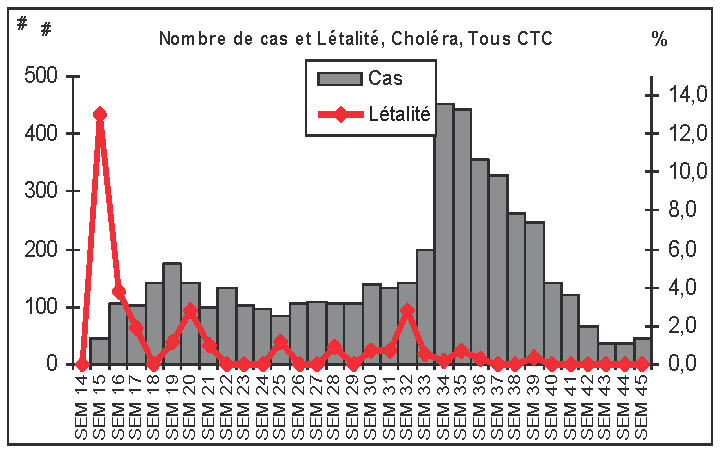8.2.1 Data collection
Epidemiologic data
The epidemiologic data are collected from cholera case registers and sometimes from individual patient files.
|
Required |
Recommended |
Optional |
|---|---|---|
|
|
|
Note: authorities are in charge of collecting, organizing and analysing data of presumptive cholera cases and deaths that occur outside of cholera treatment facilities. These data are reported by private clinics, community health workers, morgues, etc.
Consumption data
Consumption and stock of essential items (i.e. ORS sachets and litres of RL) are taken from pharmacy stock cards.
8.2.2 Graphing cholera case and death data
As the data is collected and tabulated usually in an electronic database, daily or weekly totals of cases and deaths, expressed as case fatality rate, can be graphed as an epidemic curve.
When data from all reporting treatment facilities from a city, district, or country are combined, the global evolution of the epidemic can be visualized (Figure 2).
Presenting daily totals of cases and deaths may be useful at the beginning of the outbreak to aid in decision making, however, by convention, weekly tallies are used throughout the epidemic.
Figure 2 - Weekly number of cholera cases and CFR, Ndjamena, Chad, 2011.

When patient origin is being recorded on the cholera registers, the weekly tally of cases and deaths can be compiled for each location.
- aAny person who arrives alive but dies in a cholera treatment facility should be counted both as a case and a death. Other outcomes (cured, transferred out, leaving against medical advice) should also be recorded.
Persons who die before arriving at the treatment facility can be recorded by this facility as “brought in dead” but should be counted as a community case and death. - bEpidemiologic week: typically Monday through Sunday or Sunday through Saturday.
- cAge groups < 5 years and ≥ 5 years are usually sufficient.
- dDehydration level: none/some/severe.
- eAccording to the smallest administrative level possible, i.e. to the 4th level (e.g., neighbourhood, city, district, and region).
- fDouble counting may occur if a transferred patient is reported as a case by both the initial and receiving facility. All actors should agree on which facility will count the case, based on the decision of the national surveillance system.